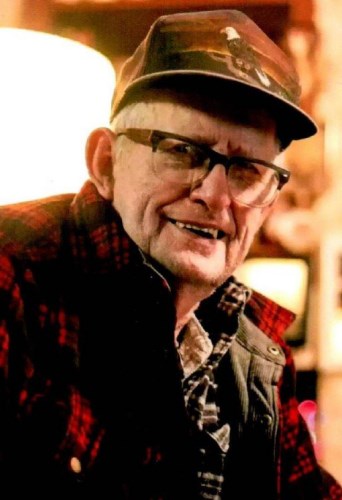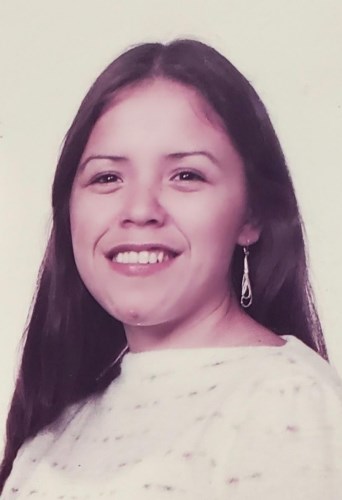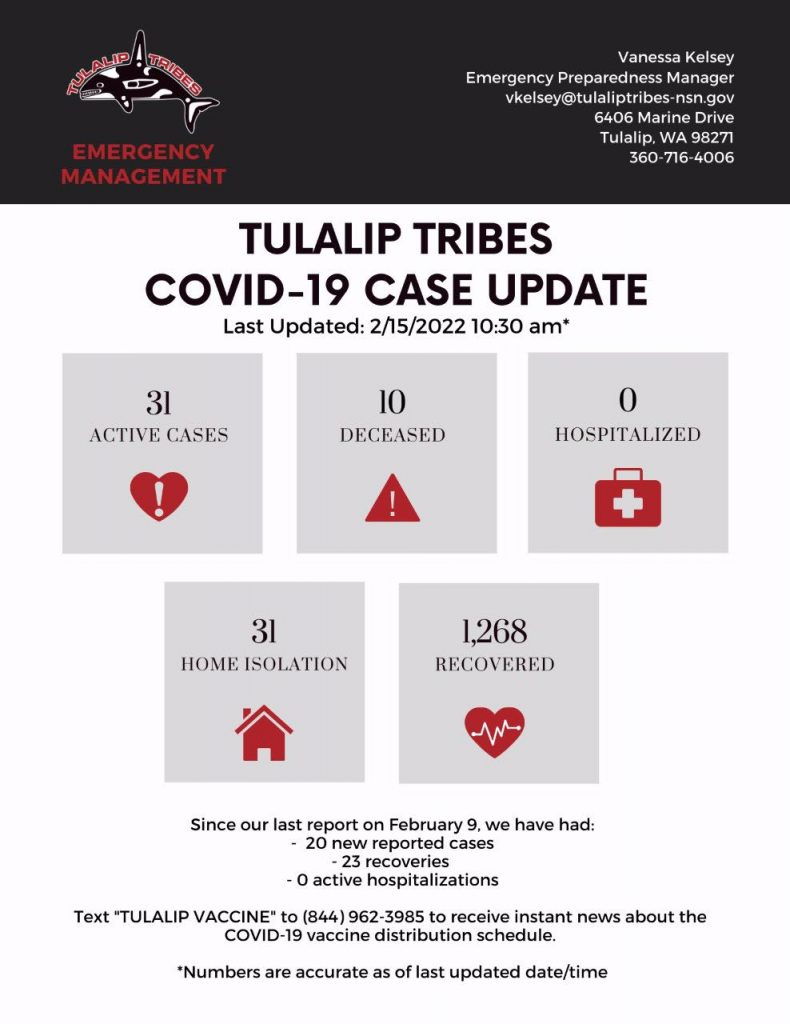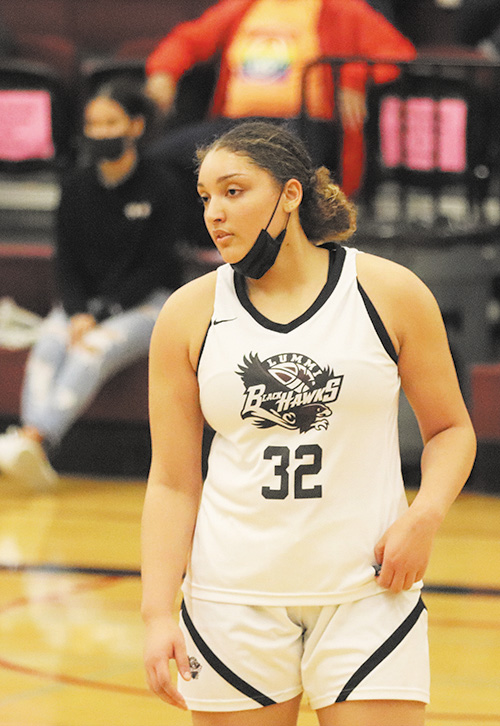Please follow the link to download the February 19, 2022 issue of the syəcəb
Newest Youth Council sworn-in

By Micheal Rios, Tulalip News
Way back in the simpler times of 2015, then President Barack Obama issued a call to action at the United National Indian Tribal Youth (UNITY) annual conference. He referred to this call to action as “the first step in engaging a broad network of people interested in addressing the issues facing Native youth and creating a platform through which Native youth can access information, opportunities and resources. [Most Importantly, to] have their voices and positive contributions highlighted and elevated.
“We want to give those young people and young Native American like them the support they deserved,” the former President continued. “We have to invest in them, and believe in them, and love them. And if we do, there’s no question of the great things they can achieve – not just for their own families, but for their nation and for the United States.”
Those words inspired the next generation of Tulalip leaders to heed the call to leadership. The teenage youth thoughtfully and expeditiously created the first-ever Tulalip Youth Council as a result. Since it’s inception seven years ago, Youth Council continues to develop excitement amongst our young people to engage in cultural activites and local events, while proudly representing the youth voice at Board of Director’s meetings.
The latest rendition of youth leadership, known as the 2022 Tulalip Youth Council, was sworn-in by Chairwoman Teri Gobin on Saturday, February 5th.
Prior to being sworn-in, each attending youth took a moment to introduce themselves in the traditional way. Tribal leadership was stunned as a majority of young culture bearers spoke Lushootseed while introducing themselves and shared who their parents and grandparents are.
“This is the first time I’ve heard so many youth speak Lushootseed, our language, in the board room or anywhere else for that matter,” marveled Board of Director Glen Gobin. “To be able to open up and share what’s been handed down to you from our ancestors shows the passion each of you has to learn and embrace our culture. Our elders are so encouraged to know our Tulalip youth are bringing the language back.
“It’s so important we have youth be involved in our Tribe and to know who we are as Tulalip people. One day, members of this Youth Council will be sitting here as Board of Directors because you were willing to stand up, be involved, and actually care about what’s happening in our community. I am encouraged and feel secure knowing we have future leaders who want to learn, understand, and provide for the next generations. Your Tribe is proud of you.”
After taking their oaths and offering handmade necklaces to the Board of Directors, the three attending Senior members of Youth Council, all of which just so happen to be 15-years-old, offered their vision for the next year.
“My mission is to continue working towards getting drugs off our Rez,” shared chairman Image Enick. “By bringing more awareness to the drug problem, getting tribal members in need in contact with services that can help them get clean, and hosting events like Get Drugs Off Our Rez rallies, we can all work together to accomplish this mission. An important piece of this includes breaking down the drug issue to our young ones, at elementary and middle schools, because they are affected, too. They need to know what the devastating effects of drugs are so they aren’t tempted and know what can happen if they do drugs.”
Vice-chair Faith Valencia said, “My goals are more about cleaning up our community, like removing garbage from our streets and neighborhoods and getting more people to recycle. I’d like to see more recycle bins at our common areas so that people have more of an option to recycle than just throwing everything away. By having more community clean-ups we can reach more people and help make them aware.”
Treasurer Johnathon “JD” Rinker added, “I’d really like to see more of an effort to get our community garden going. Having our people learn to garden, understating the different types of soil needed for growing plants and vegetables can make a big difference in getting more people healthy. We have people with records that can’t get jobs, so by creating job opportunities for them at the garden they can get their life back together and learn a valuable skill that they can teach others.”
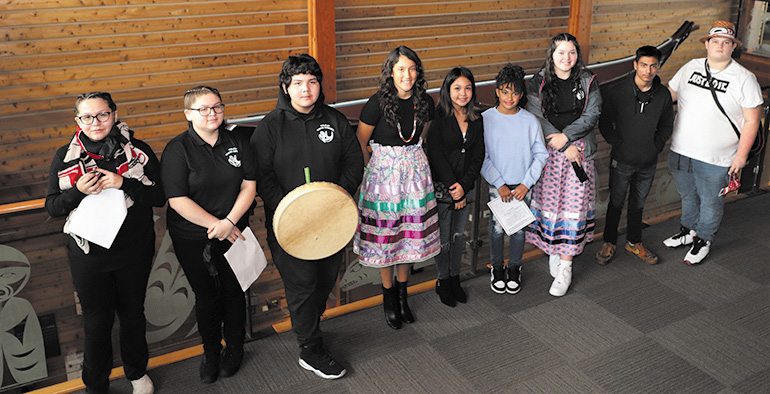
In attendance at the swearing-in were two previous Youth Councilmembers who wanted to support their fellow tribal members. Eighteen-year-old Evelyn Vega-Simpson and seventeen-year-old Sebastian Gomez spent the previous two years as officers on Youth Council and shared how their time in leadership positions helped them grow as individuals and gain invaluable experience for future endeavors.
They shared that a definite highlight of thier time on Council was creating a Wellness Warrior video that won 2nd place at the UNITY conference, while also being very proud of creating the first-ever Tulalip Pride Walk. They also spoke of the multiple collaborations with Tulalip departments and services in gaining more momentum for community-based events.
“For me, being on Council during the pandemic meant we become a source a of positivity and optimism for our people. Always looking at the bright side that we had each other and being part of a community that cares for one another,” said Sebastian. “I was very shy when I first joined, but quickly had to learn to speak to people I didn’t know and gained so much public speaking experience. Ultimately, I learned to step outside my comfort zone and be more confident in myself and my abilities.”
“When I joined initially it was to not only help the community but to learn more of our language and about our shared culture,” added Evelyn. “Through all the experiences and events we got to attend and be a part of, we learned more and more about the culture. What it means to be Tulalip and how to represent ourselves as Tulalip tribal members. So when I look back at the last few years I’m really thankful for the opportunity to get to know more about the community and to have met so many of our people.”
While no official projects have been decided on yet, the newest version of Tulalip Youth Council will meet regularly under the guidance of their advisor, Shane McLean. Many of the newest members said they hope to participate in national events and do some travelling like previous Councils have done. Their shared optimism lies in working in their community and volunteering with local organizations and schools to address what they view are areas of most concern.
We wish them the best of luck and look forward to updating our readers on future Youth Council activities.
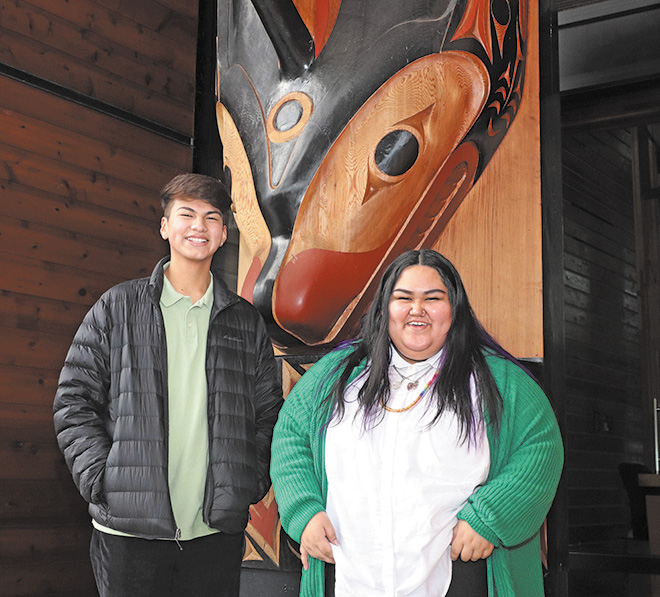
Official Roster
Sr. Council:
- Chairman- Image Enick
- Vice Chairman- Faith Valencia
- Secretary- Calista Weiser
- Treasurer- Johnathon Rinker.
Jr. Council:
- Chairwoman- Kyla Fryberg
- Vice Chairman- Bradley Paul-Williams
- Secretary- Terrance Nguyen
- 8th grade rep- Able Charley
- 7th grade reps- Kileea Pablo & Arielle Valencia
- 6th grade rep- Aylani Lewis
- Media Coordinator- Elijah Cheer & Faith Iukes
Youth Council Advisor- Shane McLean
Donald Heinze Brodersen
October 16, 1931 – February 13, 2022
Donald Heinze Brodersen aka “Grandpa” was born October 16th, 1931 on his family farm near Arlington, Washington to Henry Brodersen and Anna Rose Kraetz Brodersen he was 1 of 8 children.
Donald grew up on that same farm and graduated in 1951 from Arlington High School, he lettered in track and was an avid member of FFA. He then joined the Armed Service November 17th, 1952 serving as an MP for 2 years before transferring to the reserves until 1960 when he received an Honorable discharge.
That same year of 1960 he met the love of his life Vera M. Zackuse at a cafe in Marysville Wa. Soon after they moved to Smith Island where Don worked full time on the Island until he gained employment at Weyerhaeuser where he retired serving 20 years.
Don and Vera resided at Smith Island for 13 years and in 1973 they bought a 5 acre track in Tulalip, Wa. now known as the Zackuse Compound where they continued to raise their growing family.
Throughout the years to follow Donald enjoyed his life of raising numerous children spending time with Nieces, nephews, grandchildren, great-grandchildren and Great-great grandchildren.
The life of Razor Clam digging, farming, gardening, traveling to all the kids sporting events and camping were some of his fondest memories.
Donald worked his entire life and was committed to everything he did, passing down that teaching to his future generations.
Donald went on his Journey on February 13th, 2022 at 4:37 p.m. in the same home he had lived in for nearly 50 years, surrounded by the love and strength of his family.
He is survived by siblings Rose Mary Ford, Bill Brodersen, Roger Brodersen and Debbie Brodersen. Children Morris Zackuse, Mitch (Karen) Zackuse, Brenda Zackuse (Richard), Leona Zackuse and Elishia Stewart. Grandchildren Jimmy Zackuse, Tory Chuckulnaskit (Kris), Shiloh Zackuse, Mitchell Zackuse, Tristin Zackuse, Nicole Zackuse (Michael), Joe Zackuse (Annie), Shawneen Zackuse (Doug), Heidi Fryberg (Marlin), Michael Addie, Leona Addie, Kimberly Addie, Juan Gonzalez, Kiana Hernandez and TyReece Hernandez. Great-Grandchildren Cheryl Mae Chuckulnaskit, Kristy Chuckulnaskit, Jalen Chuckulnaskit, Wesley Zackuse, Shaughnessey Zackuse, Elyssa Zackuse, Shylah Zackuse, Ryelon Zackuse, Deven Zackuse, Kecia’Ann Zackuse, Makayla Zackuse-Moseley, Chayce Zackuse-Moseley, Ryleigh Zackuse-Moseley, Ashlee Salinas, Cullen Zackuse, Hallie Zackuse, Aubrey Zackuse, Mekiah Phillips, Logan Fryberg, Leighton Mitchell Fryberg, Ellie Rose Fryberg, Zane Addie, Sophia Romero, Julio Romero, and Jayden Romero. Great-great grandchildren Waylin Zackuse #5, Kaliyah Chuckulnaskit. Special outlaws Doug Salinas, Marlin Fryberg, and Annie Zackuse. Special nieces Linda Hill, Kathy Williams, Sheryl Fryberg, Verna Hill, Candy Hill-Wells, Special Nephew Charles Hill, extended family and his dog Precious aka “Stinky”.
Preceded in death by Vera Zackuse the love of his life, parents Henry and Rose Brodersen, Brothers Lawrence Brodersen, Ralph Brodersen and Sister Louise Brodersen.
Elders, veterans head to LA for Super Bowl experience
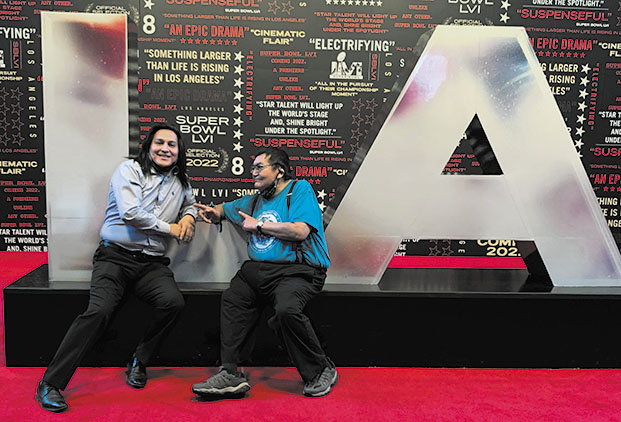
By Micheal Rios; Photos by Malory Simpson
Over 112 million viewers tuned in to watch this year’s Super Bowl clash between the Los Angeles Rams and Cincinnati Bengals. Among the sold-out 70,240 person crowd that travelled to L.A. to witness the big game in person was a very lucky group of Tulalip tribal members.
Made possible by a recently announced partnership with DraftKings, Tulalip leadership raffled off exclusive suite tickets to tribal elders and veterans. The lucky benefactors were Maurice “Hammer” Alexander, Rocky Renecker, John Ancheta, Nancy Koehler, Sara Andres and Patricia Balderson. Plus their official escort, events manager Malory Simpson.
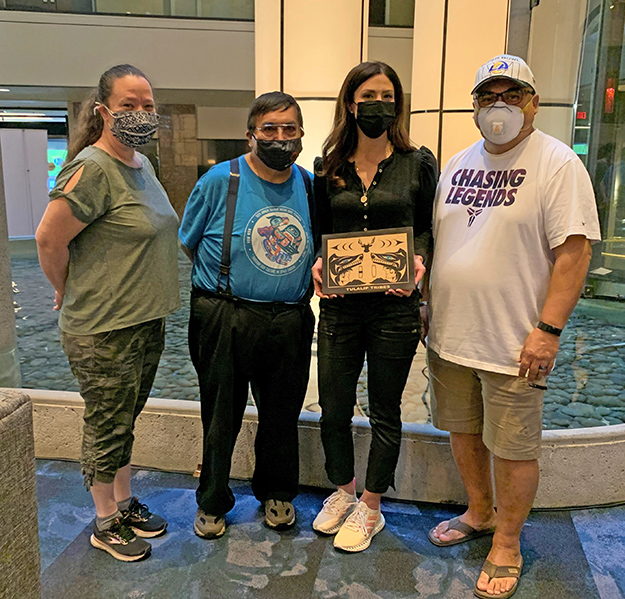
“The experience was definitely once in a lifetime!” shared Malory. “We were able to attend some events hosted by DraftKings, one on Saturday night and a tailgate party the day of the Super Bowl game. There was tons of free food and drinks, as well as a concert by Wyclef Jean, which was absolutely amazing. It was great to hear live music after COVID, you know?!
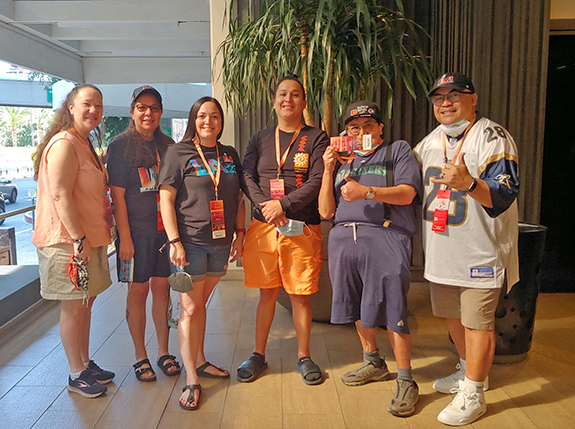
“The suite was immaculate and filled with lots of food, drinks and hospitality,” she added. “The group of elders and veterans made my job easy. I am so grateful for the time I got to spend with each of them. Big thank you to the Board of Directors for the tickets, to our Travel Department for booking our flights and shuttles, and the CEO staff for thinking of me to escort our elders to Super Bowl LVI.”
Local artist Walter Moses created a special piece for the occasion that was gifted to the DraftKings representative by the group at the stadium. “I can tell you she was grateful to be gifted such a stunning piece of artwork. She mentioned to us that she’s never been gifted a piece of art from her clients before,” said Malory.
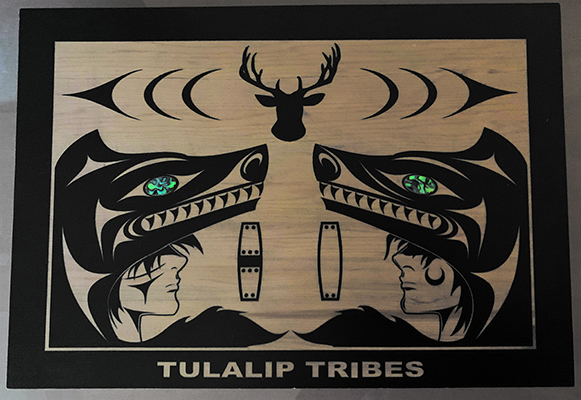
The football event watched around the world featured a thrilling game that went down to the wire, an exciting halftime show starring hip hop legends, and a $5 billion SoFi Stadium venue in Los Angeles that added a uniquely Hollywood flare. For the Tulalips in attendance, memories were made and experiences had that are sure to last a lifetime.
“I had an amazing time,” shared Tulalip veteran Sara Andres. “I was super happy to be given this once in a lifetime experience and to be able to share it with the others. I am so thankful the Board of Directors offered the tickets to Tulalip elders and veterans. Having been the third alternate called, I didn’t think I would be going. I am very grateful for the winners that gave up their opportunity for me to be able to attend. I will never forget Super Bowl LVI. GO Rams!”

Bonnie Lou Jones-Onefeather
July 31, 1959 – February 9, 2022
Bonnie Lou Jones-Onefeather, (62) who was known to everyone as “Bon Bon” passed on February 9th 2022. She was born to William Lawrence Jones Sr. and Etta Frances Jones in Everett, Washington on July 31, 1959.
Her spirit was strong, her light burned bright, her beautiful contagious smile radiated through to everyone that she knew.
She enjoyed fishing and cooking on the beach with her dad and extended family, going to bingo, doing arts and crafts, spending time with her kids and grandkids as well as stopping to enjoy the flowers. Always had goodness in her heart, her joyous energy was seen by all. She got her GED from Everett Community College in 1979. Afterwards she worked for the bingo-hall. Then she enjoyed being a stay at home mom. Despite all odds of mom being in a wheelchair and all of her kids telling her no, she was determined to prove all of them wrong.
She is survived by the love of her life Dan Follestad, her children Jamie (Jesse) Guzman, Jimmy Jones, Samora (Chris) Joseph, Lenetta (John) Rivera, and Bonnie “Punkin” Follestad , siblings brother Kirk (Bonnie) Jones, sisters Diann Akana, Rita (Dana) Matta, Virginia Nancy McClellan, Valerie Matta and Georgia Jones, grandchildren Jesslynn, Brielle, Jesse II, Marcello, Chelsea, Eternity, Natalie, James, Jimya, Daylen, Summer, Jimmy, Violet, Alexis, Matilda, Makena, Amelia, Christopher, Stella, Rozlynn, Rockell, Raylynn, John Boy, Krysta and Myliana, great-grandchildren Christian II and Carter. Numerous nieces, nephews and cousins.
Preceded in death by her Grandparents Ma and Pa Jones, parents Etta Frances Jones and William Lawrence Jones Sr, siblings Juanita Jones-Morales, Dale “Buck” Jones, Peggy Sue Shopbell, William “Bj” Lawrence Jones and baby Keith Jones.
Ryan’s REZ-ipes: From best-kept-secret to a countrywide fan favorite
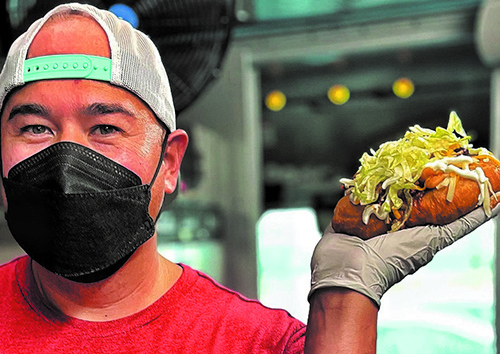
By Kalvin Valdillez; photos courtesy of Ryan Gobin
Six years ago, a Tulalip man took a leap of faith and gave up his ten-year career as a police officer for his love and passion of food. Briefly opening a concession stand outside of the local CrossFit gym, Ryan Gobin began serving up tasty dishes to the tribal community, and the response he received from that endeavor led him to the investment of a small food truck. After hitching a smoker to the food truck, he held a competition online asking his friends and family for ideas on what to call his new restaurant-on-wheels. With a name and a very interested and hungry patronage, Ryan’s REZ-ipes officially opened up shop in 2016.
Serving up the likes of frybread, truffle fries, pulled pork sandwiches and tacos, burgers, shrimp bowls and a variety of weekly specials and experimental dishes, Ryan’s REZ-ipes has gone from a locally known best-kept-secret to a countrywide fan favorite with thousands of followers on social media. Many self-proclaimed foodies and food industry professionals alike often tag their friends on Ryan’s photos with a comment along the lines of ‘we gotta try this’. Ryan’s REZ-ipes is now available through delivery services such as DoorDash and he even began selling some of his signature spices and mixes for you to try at-home.
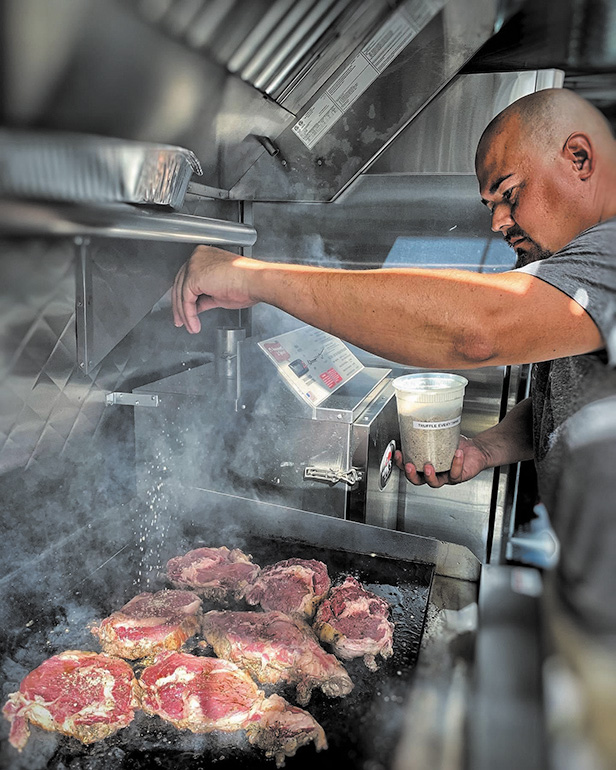
Ryan’s journey is the perfect blueprint for up-and-coming tribal entrepreneurs to follow. From a concession stand to a shiny beaut of a food truck, he has grown his brand incredibly over the past several years, incorporating a Native American logo and adding catering to the business. It’s gotten to the point that whenever you see his blue food truck, your stomach might growl and your mouth will more-than-likely water just thinking of his Indigenous and multi-cultural inspired cuisines.
When he was first getting his start, Tulalip News sat down with the tribal chef and businessman to talk about the inspiration behind his new venture, to which he responded, “I first got into cooking in my teen years. I have lots of family members that are amazing cooks and have been taught many recipes from all of them. I watched when people cooked in my younger years and began trying my own recipes. I could name everyone I learned from, but that would be a long list.”
With six successful years under his belt, Ryan recently took some time out of his very busy schedule to talk with Tulalip News once more about his passion for cooking and growing his business, as well as to discuss all the success he’s had since first beginning his culinary experience.
Since we last spoke, Ryan’s REZ-ipes has continuously leveled up every year. Can you talk about your journey since then? What has been a few of the major highlights of the business over the years?
I’d have to agree with leveling up! The business has definitely taken off at a rapid pace since the upgrade of a new food truck. The amount of events and weddings have quadrupled in the past two years and are continuing to increase. I already have 18 weddings booked for 2022, and I am still getting more requests weekly.
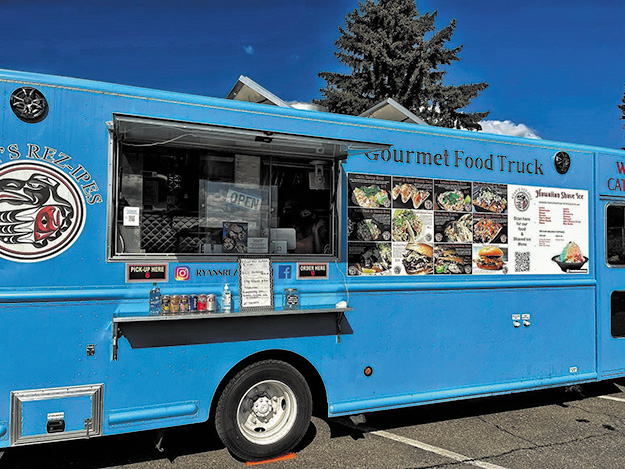
You mentioned the new truck, can you touch upon some of the truck’s features and equipment? How has that benefited your dream of serving tasty dishes to the community?
Having a new food truck has helped immensely – having all brand-new equipment and an on-board smoker. Instead of having to plug multiple warmers in a power source, and having to use a loud generator mounted on the back, I now have professional plumbed propane heating warmers, a fryer and a flat top griddle.
It’s the Cadillac of food trucks. I even incorporated a stereo system that sounds like an outdoor nightclub and LED lighting to create a colorful ambiance. Since having this truck and showing others the potential of what can be done, I now have had over a dozen other food truck owners coming to me for advice, from multiple states across the U.S.
You have a lot of new items on the menu and many of them have cultural ties. What are some of those dishes and what is the inspiration behind some of those popular plates?
I have multiple new items and some of my oldies too. Over the years I’ve utilized my skills with trial and error – making everything better and better, and finding where to gather those ingredients to achieve the best quality.
I’ve been all over the board in bettering different items, such as my marinades, creating more sauces, my seasoning rub for my smoked pork and coming up with desert toppings for frybread. Years ago, I was selling frybread and always ended up running into issues where it just wasn’t perfect every time, it was either too heavy or just didn’t look right. I was given my Grandma Nonie’s recipe years ago and I just couldn’t get it right, so I gave up. This past year I tried again, but told myself I wouldn’t stop trying until I got it exactly how I want it – fluffy and perfect. I achieved my goal and now sell my own Ryan’s REZ-ipes fluffy frybread mix in professionally sealed pouches.
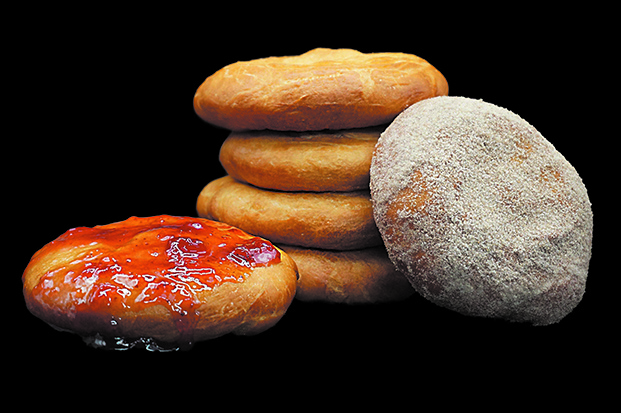
I love to travel and experience new kinds of foods everywhere, which is how I came up with a few of my dishes like my Korean-style kalbi steak, my Hawaiian-style chicken tacos and even my shrimp dishes. Whenever I try something and just crave it, I figure out how to make it myself, then I put my own twist on it. Different cultures have their own kind of traditional flavors, and they all inspire me to create explosive flavors that make your tastebuds dance. It’s pretty obvious that I’m greatly inspired by the Hawaiian Islands just by seeing a lot of the dishes I choose, such as one of my recent specials the loco moco with fried rice, which is a Hawaiian traditional dish. You will also see Hawaiian shaved ice on my menu, which actually originated in Japan.
After cheffing it up over the years, you are obviously still very passionate about cooking and providing meals to the people. What motivates you and fuels your drive now that you are living your dream?
My passion continues to grow the more I see smiles on everyone’s faces after they eat my food. It enhances my drive to continue to figure out new dishes and to give everyone new foods to try. I now have over 8,000 followers on social media, so my foods are seen across the U.S. and also in other countries. That drives me to want to build an even larger business, which will happen in due time.
Catering is now a big aspect of Ryan’s REZ-ipes that I don’t believe you were doing yet at the time of the last article. Could you talk about your catering options and the process? What are some of the events you’ve catered this far and what makes catering enjoyable for you?
Catering is huge in the food industry. I have now catered over 150 events and still growing daily. We cater anywhere from 100 people to 1000. I have catered multiple birthdays, corporate events, baby showers, celebrations of life, weddings and we even catered last years Tulalip employee day at the amphitheater. I love it because food makes everyone happy. I also cater weekly for a company that is building an all-electric airplane, over 100 employees each week. I have a large catering menu to choose from and that can be located at ryansREZipes.com.
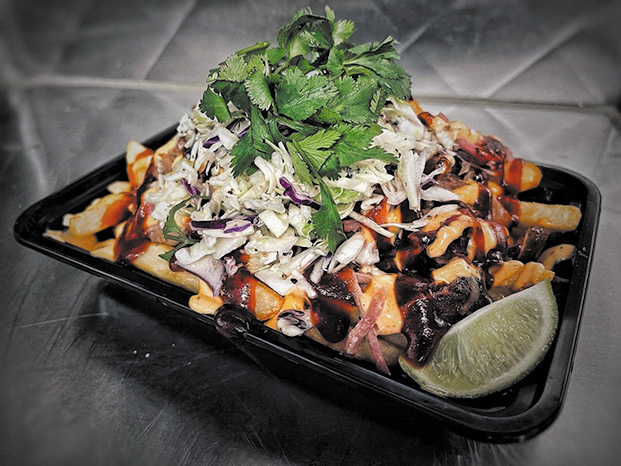
Can you talk about some of the new and exciting updates happening at Ryan’s REZ-ipes?
My newest update is that I’m adding garlic rosemary truffle fries and frybread to my menu, and I will be finding new unique ways of utilizing them, such as adding dessert toppings, or pairing with a hickory smoked hot dog and a number of toppings. One update that I’m happy to announce is I will be looking to add a food trailer to the fleet. I will be separating the shaved ice from the food truck. This will allow me to have more room to focus on shaved ice and Lotus drinks with amazing toppings, and maybe even cotton candy will be added to the mix! We will also do dessert frybread there, so it will basically be more of a dessert trailer.
Ryan’s REZ-ipes serves as an inspiration to many tribal members and proof that you can follow your life’s passion, not only to aspiring chefs, but to all tribal entrepreneurs as well. Any words of advice for those just starting out, or those who are looking to start their own business?
The best advice I can give to those that would like to start their own business is never give up – ever. You will have doubts and there will be a lot of roadblocks. You just need to always remember that nothing is ever instant. It can take years to create the profits you aim for, not days, weeks or months. Trial and error is key. If you make a mistake, learn from it and keep pushing forward in a good way. Lastly, make small goals and work daily to achieve them. No matter how small the achievement is, it’s still an achievement.
What are your typical hours and where can people find you? Any upcoming events or anything new on the horizon you’d like to share?
In the upcoming months and years, our locations, days we’re open and times of operation will change, being it’s a food truck that serves food and does private catering as well. But typically, right now, we’re located at the Tulalip Market which is a great location. We are there Thursday – Saturday and every other Sunday. Those days and locations will even rally change though. So, you can stay up to date by following the Ryan’s REZ-ipes Facebook page.
Tulalip Tribes Covid Case Update, February 16
February 12, 2022 syəcəb
Please follow the link to download the February 12, 2022 issue of the syəcəb
Tribal teens are growing through Youth Night
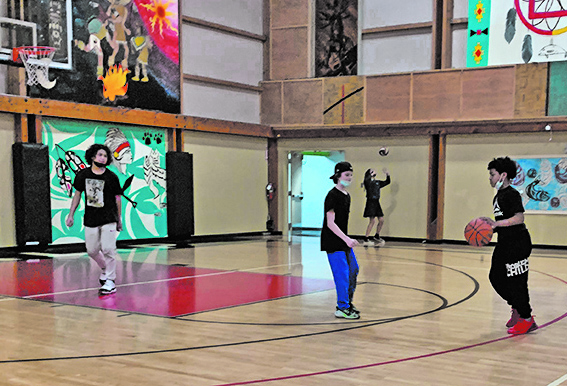
By Shaelyn Hood, Tulalip News
More often than not parents are trying to find programs and groups that are going to help uplift their children, build life skills, and let them hang with kids their age in a safe place. If you have a child between 6-12 grade, the Education Division’s Youth Night might be the place for you.
Much like other gatherings, the Covid-19 pandemic has made it difficult for people to come together, and celebrate life in all its form. A social group that is heavily dependent on the voices of others, is youth. Specifically, when talking about teenagers. These years of their life are so important, because they are learning about who they are and what they want to be. They’re becoming less reliant on their parents for daily tasks, and building habits of their own.
According to a 2020 survey by UNICEF, because of Covid-19, more teenagers in the U.S. are suffering from anxiety and depression, 46% of kids have less motivation to do activities they used to do, and 73% felt they needed help concerning their mental and/or physical health. Without the skills that are learned from having a healthy routine, socializing with others, and doing daily tasks like working and going to school, it has hurt teenagers in a way that could be detrimental to how they start their adult life.
As parents and community leaders, there is little to what can be controlled in a global pandemic. But as things have started to re-open, departments like the Education Division have been trying their best to seize the moment.
Primary leader for the Youth Night events, Adiya Jones-Smith said, “The first couple weeks we just want to focus on team building, and then we’ll get more into interpersonal communication skills. Lastly, we want to target safe thoughts and get them outside their comfort zone, and express how they may be feeling or what they may be going through. Because who knows, they might be able to relate to one another.”
She went on to talk about how it’s important because these are activities and skills that kids don’t normally get to experience in school. Since it is at the Youth Center, it is a perfect time to get them out of the house, and keep them engaged outside of school.
When speaking with one of the tribal youth who attended the event, she said, “Sometimes I’m bored after school. I come here once in a while. I’ve made more friends and I get to have more stuff to do.”
Sometimes, that’s all a child needs; time spent with friends, and an area to decompress.
Youth Night takes place every Monday, Tuesday and Wednesday from 3:30-4:30 PM, at the Don Hatch Youth Center. During the event, food and snacks are supplied by Uppy’s Kitchen. Other than the program’s organized activities, kids can hang out, socialize with one another, and play in the gym with basketballs, volleyballs, etc.
Events like this have the ability to build our adolescents, by reducing risky behaviors, helping academic development, and promoting overall physical and mental health. It is available for any tribal youth from 6th-12th grade, and there is no sign-up necessary. If you would like more information about Youth Night, please contact Adiya Jones-Smith at adiyajones@tulaliptribes-nsn.gov.
‘New team, same dominance’ for Tulalip’s Jacynta Myles
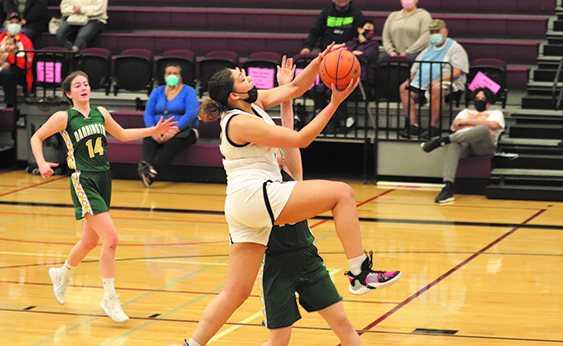
By Micheal Rios, Tulalip News
She’s too humble to admit she’s a dominating low post player on the basketball court. Yet anyone who has been following Jacynta Myles’ high school career knows it’s a simple truth. She’s too big, too strong…simply too much to handle one-on-one for any Northwest 1B high school program. And now playing for Lummi Nation, she’s looking to make one last playoff run before her high school days are over.
During her freshman and sophomore years, Jacynta was a foundational player for Tulalip’s Heritage High School. She was a walking double-double even while still adjusting to her still growing, powerful physique. Then the pandemic hit. She managed to still dazzle her opponents with monster stat lines in her junior year while wearing a Heritage Hawks jersey. But going into her senior season, she was forced to make a change.
A combination of factors, largely due to the ongoing pandemic, led to Heritage sports being temporarily disbanded. The athletes were granted permission to continue playing sports at other high schools. Most chose programs in Marysville, but not Jacynta. The 18-year-old culture bearer refused to play for a non-Native basketball team. So what did she do? Routinely drive herself from Tulalip, all the way up to Lummi, in order to gain eligibility, that’s what.
“I really hoped we could’ve had a basketball season at Heritage for my senior year, but it wasn’t meant to be,” reflected Jacynta. “I love being Native American and representing our culture through sports, especially basketball. Our crowds are always so passionate and really enjoy seeing us play. So when that all got cancelled, my choices were to play for a school that doesn’t really represent us or play for our on-court rival, Lummi. It was a no brainer for me. I chose the culture.”
Long-time rivals, on the court anyway, Lummi Nation hoops welcomed the towering Jacynta with open arms. Sure, there was an adjustment period, more so because the guard heavy BlackHawks weren’t used to playing with a truly talented post player before. However, once both player and team got used to one anther the results spoke for themselves.
Fueled by Jacynta’s presence in the paint anchoring their defense and her low post dominance on offense, Lummi reeled off one W after another. Coach Krista Mahle explained by adding Jacynta to the team, her guards were able to play a much more up-tempo style. Four wings who can all dribble, pass and shoot typically share the court with Jacynta.
“Jacynta has been a game changer for us,” said Coach Krista. “She’s been a leader for my girls and helped them develop really develop their games. We’ve been so happy to have a player of her caliber on our team.”
Lummi’s new style of play with Jacynta at the center spot created havoc for their opponent’s coaches. Do they sell out to slow down the biggest girl on the court or focus on the perimeter ball handlers and let Jacynta have her way in the post? Neither strategy worked particularly well.
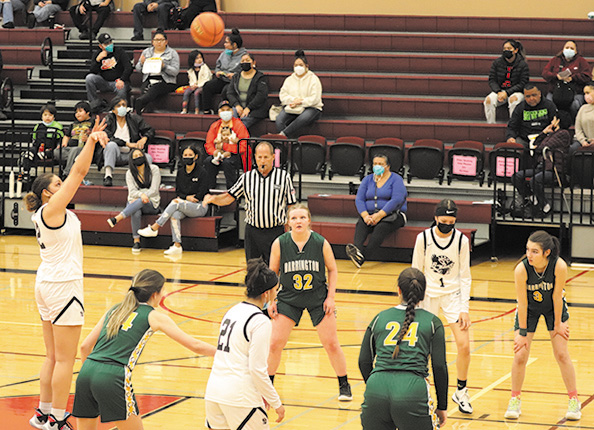
The BlackHawks dominated the regular season with a league best 7-1 record. After getting a first round bye, they hosted the Darrington Loggers in a second round playoff matchup on February 5th. The game was the first home game all season that Lummi Nation allowed fans in the stands. A decent sized crowd showed up, including a handful of Tulalip families, to cheer on the all-Native BlackHawks team.
They made quick work of the Loggers who were clearly outmatched in all facets of the game. Jacynta barely broke a sweat while filling the box score. Lummi gave their excited crowd what they came to see, a 54-39 W.
“It’s been a really fun season, especially having teammates who help me be the best post player I can be, which just makes the wins that much sweeter,” said Jacynta post-game. “My teammates and coach have really embraced me. Now, together, we hope to make a deep playoff run. Personally, I’ve never been to State before, so that’s my goal. How amazing would that be to finally make it happen in my senior year?”
Next up for Jacynta and her Lummi BlackHawks is a matchup with Grace Academy on Thursday, February 10, with a 6:00 p.m. tipoff.
